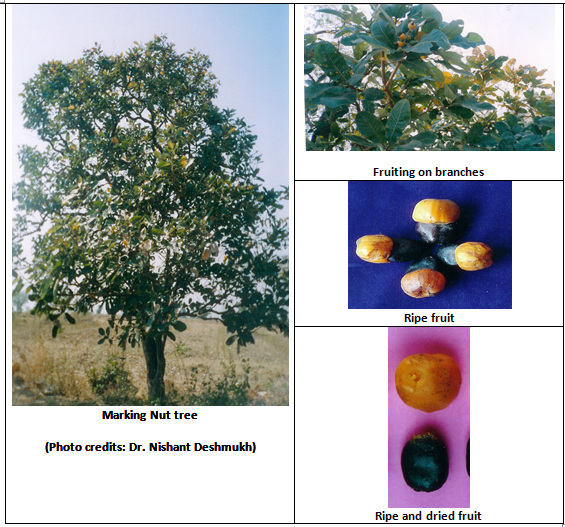Authors: Smita Shingane, Nishant Deshmukh, Dinesh Chand, Sunil Gomashe and Nilamani Dikshit
Marking nut (Semecarpus anacardium L.) of family Anacardiaceae is an important but underutilized fruit crop of India. It is native of Indio-Malaysian region and commonly grown in the hotter part of India. The tree has edible fruit (hypocarp) and kernel. The pericarp contain Bhilawan Shell Liquid (BSL) which is a rich source of Phenols (Chopra et al., 1956). Inside the pericarp protected by a hard shell is a white kernel which is sweet and nutritious as the almond. The kernel is rich source of protein (26.4 %), fats (36.4 %), carbohydrates (28.4 %) and minerals (3.6 %).
Marking nut is deciduous tree which starts flowering in June and continues upto August. The fruits mature from January to March, and shed it leaves during the month of April to May. Tree reaches upto a height of 12 to 15 meters, having stem girth of 1.0 to 1.5 m, flowers are small greenish white or yellow in colour which are subsessile in nature and are enclosed in erect and terminal panicle. Fruit is oblong drupe with seed of shining black colour when ripe, seated on an orange red to yellow coloured receptacle formed of the disk called as fleshy hypocarp (Chopra et al., 1956).
There are no regular orchards of these trees however it is found on large scale in forest. Fruiting starts at the age of 3-4 years. Seeds have poor viability and it should be sown immediately after collection. (Anonymous, 1972). The pericarp (seed) embedded in a black oily, bitter and highly vesicant juice forming about 30 to 40 per cent by weight which has been traditionally used for marking lines (Gedam et al., 1974 and Potnis and Venugopalan, 1964).
The kernel found inside the hard shell is edible and has almond like taste. It contains 3.8 per cent moisture, 26.4 per cent proteins, 36.4 per cent fats, 1.4 per cent fibre, 28.4 per cent carbohydrates and 3.6 per cent minerals. The mineral constitutes about 295 mg calcium, 836 mg phosphorus and 6.1 mg iron per 100 g of edible kernels.
The fleshy orange and cup shaped hypocarp is eaten when fruit is quite ripe. It is either eaten by roasting the fresh hypocarp or consumed as a dry fruit. It is a rich source of vitamin-A about 185.50 mg, thiamine (B) 0.39 mg, riboflavin (B2) 0.15 mg per 100 g of edible hypocarp (Bhalerao, 1990).

The vesicant juice extracted from pericarp of marking nut is known as Bhilawan Shell Liquid (BSL) in trade is a rich source of phenol. Non-vesicant semi solids or solid resins from BSL are utilized as a bases for the manufacture of varnishes, lacquers, enamels, paints, moulding composition, water proofing and insulating (electrical) materials. Chlorinated derivatives of the phenolic constituents of BSL have been produced for the use as insecticides, antiseptics and termite repellents. They have also been used as starting materials for the preparation of synthetic detergent, herbicides and fire proofing plastics.
References
1. Bhalerao VV (1990) Studies on preservation of marking nut hypocarp. M.Sc. (Agri.) thesis submitted to Marathwada Agricultural University, Parbhani, Maharashtra, INDIA
2. Chopra RN, Nayar SL and Chopra IC (1956) Glossary of Indian Medicinal Plants. Council of Scientific and Industrial Research, New Delhi.
3. Gedam PH, Sampathkumaran PS and Sivasamban MA (1974) Composition of bhilawanol from Semecarpus anacardium. Phytochemistry 132 (2): 513-515.
4. Potnis P and Venugopal M (1964) Paintindia, 14(4):29
About Author / Additional Info:
I did PhD in Genetics and Plant Breeding from Mahatma Phule Krishi Vidyapeeth (MPKV), Rahuri, Maharashtra INDIA